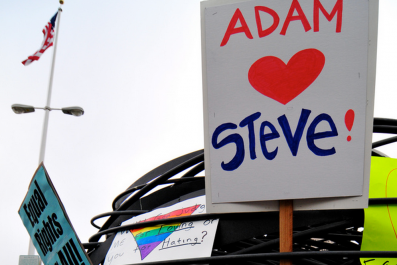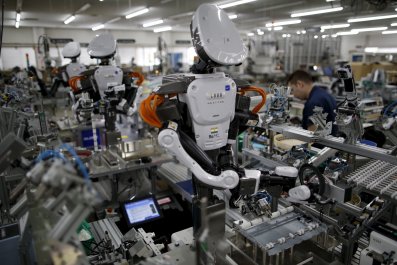Updated | Let's start with an undeniable truth: In the United States, the people have the right to keep and bear arms. And let's then acknowledge that the childish interpretation of that constitutional amendment—that Americans have the right to whatever accessory they can put on, in or over a gun for the sole purpose of making it more deadly—is a dangerous falsehood.
Therein lies the chasm between those seeking constitutionally impossible forms of gun control and their political opponents, who view every proposal regulating weaponry as the first step toward dictatorship. Caught in the middle are the majority of Americans who think people should be allowed to keep guns but seesaw over tougher laws regarding those weapons.

There is, however, a simple solution, a common-sense compromise that will infuriate both sets of extremists in the gun debate, but would place the United States on a saner path:
- Ban accessories that serve no purpose other than to transform guns into weapons of mass slaughter, such as attachable drums that carry 100 rounds.
- Adopt rules that make it harder for criminals and the mentally ill to obtain firearms.
- Outlaw the public display of weapons.
- Allow the concealed carry of guns using the "shall issue" standard.
- Stop trying to ban scary-looking add-ons that primarily protect the shooter, but don't make the gun more dangerous to others.
- Forget attacks on the "armor-piercing bullets."
- Abandon efforts to outlaw "assault weapons"—a politically loaded phrase with a mishmash of meanings that pretty much amount to nothing.
While any compromise is anathema to the absolutists, it will benefit the rational middle. "Gun control is more analogous to a tourniquet than a Band-Aid," says Osha Gray Davidson, author of Under Fire, a history of the National Rifle Association. "Tourniquets save lives, and so will a gun control policy based on balancing rights and responsibilities."
Related: Selling the Public on Guns
All gun control debates turn on interpretations of the Second Amendment, the worst written and most bizarre part of the Constitution. For example, did you know there are two Second Amendments, one passed by Congress and a variation ratified by the states and authenticated by Thomas Jefferson when he was secretary of state? Congress's version—made up of syntactically nonsensical fragments—won the day in the courts, but both versions are grammatical nightmares. Congress's version reads, "A well regulated militia, being necessary to the security of a free State, the right of the people to keep and bear arms shall not be infringed." In the version authenticated by Jefferson, the first comma disappears, transforming the words to a more typical—yet still grammatically confusing—dependent clause followed by an independent clause. That might not sound like much of a difference, but under rules of written English, the words of the amendment used by the courts don't make sense. The confusion has been so great that, in a major Supreme Court case, linguistics professors submitted a brief providing the justices with lessons on the punctuation and grammar.
Throughout the 20th century, that first clause has been argued about endlessly. In a 1939 case, United States v. Miller, the Supreme Court held that—because of the opening word fragments of the amendment—the right to weapons (in this case, sawed-off shotguns) had to be read in conjunction with the Militia Clause in Article 1, Section 8. The court wrote, "In the absence of any evidence tending to show that possession or use of a [sawed-off] shotgun…has some reasonable relationship to the preservation or efficiency of a well regulated militia, we cannot say that the Second Amendment guarantees the right to keep and bear such an instrument."
In other words, gun owners in the United States had no right to buy, sell or possess any firearms unless those weapons were reasonably connected to a militia's needs.
That remained the law of the land for decades. That is, until the District of Columbia overreached in 2001, and effectively banned handguns and required owners of firearms to keep them unloaded and disassembled. A lawsuit was filed, the District lost, and it appealed to the Supreme Court. In the landmark 2008 case, District of Columbia v. Heller, Justice Antonin Scalia ruled that the first clause of the Second Amendment could essentially be ignored. Despite the critical role those words played in the Miller decision, they did not, he argued, qualify the independent clause that followed. Rather, he opined, the words were a "prefatory clause," something akin to a blare of trumpets to declare that a new right was about to be enumerated. "The former does not limit the latter grammatically, but rather announces a purpose," Scalia wrote.
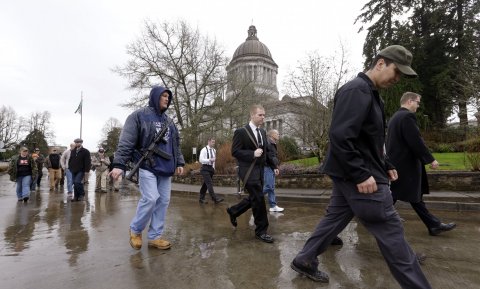
With that, only the independent clause—"the right of the people to keep and bear arms shall not be infringed"—was deemed important. Gun controllers wailed and gun enthusiasts cheered. But that was largely because few of them seemed to have read all of Scalia's opinion. As every first-year law school student knows, constitutional rights are not absolute. Newspapers stay in business thanks to the First Amendment's guarantee of freedom of speech, but they cannot lawfully print child pornography. And citizens have no right to incite imminent violence. Similar restrictions apply to other constitutional rights—most have parameters designed to protect society.
Scalia clearly stated in Heller that the right to bear arms had boundaries. "Like most rights, the Second Amendment right is not unlimited," he wrote. "It is not a right to keep and carry any weapon whatsoever in any manner whatsoever and for whatever purpose." For example, he cited laws that prohibit the possession of firearms by felons and the mentally ill, or that forbid them in places such as schools and government buildings, or impose conditions on their sale. He also wrote that his decision did not overrule the holding in the 1939 Miller ruling that the sorts of weapons protected are those in common use at the time, and that the "historical tradition of prohibiting the carrying of dangerous and unusual weapons" was still permissible.
In other words, even one of the modern era's most conservative justices says gun enthusiasts are wrong when they claim that any limitation on firearms is unconstitutional. Government can place restrictions on firearms with the intent of protecting society.
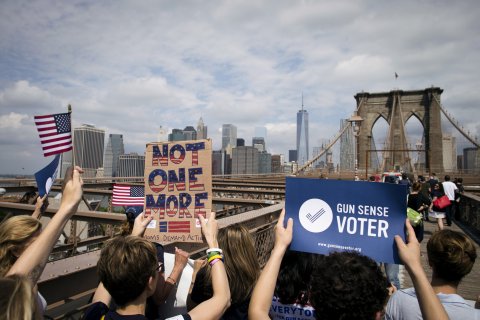
Which brings us back to gun accessories. Nowhere in Supreme Court precedent, or in the words of the founders, or in the Second Amendment (either of them) is there a right to attach stuff to a gun, including the add-ons that serve no purpose other than to kill as many people as possible as fast as possible.
Some of these accessories are largely unknown outside of the gun crowd, including such nonsensical devices as magazine drums that allow popular weapons such as the AR-15 rifle to fire up to 100 rounds without reloading.
Why would any gun enthusiast need 100 rounds? James Holmes can tell you. Until July 20, 2012, Holmes was what the NRA would describe as a responsible gun owner. He legally owned a couple of Glock 22 pistols, a Smith & Wesson M&P15 semi-automatic rifle with a 100-round drum magazine, a Remington 870 Express Tactical shotgun, 350 shotgun shells and 6,000 rounds of ammunition. Given all those purchases, his local gun club invited him to join.
Then, on that night in July, Holmes walked into an Aurora, Colorado, movie theater and started firing. He killed 12 people and injured 70 more. He got off 76 shots—65 from the semi-automatic rifle with the 100-round drum; he could have shot more if the drum hadn't jammed. In fact, Holmes told a court psychiatrist that he chose his weaponry in hopes that he would kill all 400 people in the theater.
High-capacity magazines have been the accessory of choice for most mass killers in the U.S. Adam Lanza, the shooter at Sandy Hook Elementary School who killed 20 children and six adults in 2012, used 30-round magazines. The accessory was also used in mass shootings at Columbine High School in 1999 and the military base at Fort Hood, Texas, in 2011.

The Law Center to Prevent Gun Violence reports that half of mass shooters use these magazines. Statistics compiled by the Violence Policy Center in Washington, D.C., show that just in the years Barack Obama has been president, there have been 18 mass shootings involving high-capacity magazines, killing 153 people and wounding 137 more.
A ban on these devices would force a crazed shooter to reload more often, creating more chances for the innocent to get away or even attack the perpetrator. That's how the 2011 mass shooting in Tucson, Arizona, that killed six people and injured 16 others—including Congresswoman Gabrielle Giffords—was stopped: Once the shooter's 33-round magazine was empty, he was tackled while reloading.
Firearms enthusiasts claim these devices are needed because a panicky homeowner, facing armed criminals, would be more likely to miss his target and thus need the extra bullets. Which, of course, is the exact argument against having lots of armed people sitting in a movie theater or at a school ready to fire at a mass shooter: In an emergency, those would-be Rambos are more likely to miss the target and put innocent lives in danger. Rather than wasting money on larger magazines, perhaps gun owners need more target practice.
And no, outlawing these items isn't barred by the Second Amendment. In 2013, Sunnyvale, California, banned high-capacity magazines. The NRA sued in federal court, which—citing Heller—ruled these magazines "are hardly crucial for citizens to exercise their right to bear arms." Thus, the court concluded, the potential right to a high-capacity magazine was outweighed—for the same reason the First Amendment doesn't protect bomb threats—by a strong government interest in public safety. An appeals court agreed and the Supreme Court refused to consider the issue further.
The same logic applies to other gun accessories that infringe too greatly on the government's ability to keep citizens safe. Silencers, for example. While they are subject to minimal federal regulation and already banned in 10 states, they are easily obtained and big sellers. There is no reason anyone outside of law enforcement or the military needs one except to kill people without attracting attention. Guns and accessories designed for no rational purpose other than to break the law—such as the weapons that can be made by a 3-D printer with material that won't set off metal detectors—should be forbidden.
Beyond accessories, other changes in gun laws are needed to accomplish what everyone in the debate agrees is a laudable goal: Keep firearms out of the hands of bad guys.
Unfortunately, the NRA has been working for years to make sure lunatics and felons can obtain guns as easily as possible. After the deadliest shooting in American history took place at Virginia Tech (32 dead), Congress passed the NICS Improvement Amendments Act of 2007. When introduced, the legislation called on states to submit mental-health records to national databases maintained by the FBI. The NRA declared this violated the Second Amendment and, through intense lobbying, limited the definition of mental illness only to people institutionalized or found by a court to be a danger. Even if a psychiatrist believed a patient posed a threat, nothing could be done to keep a gun out of that person's hand.

Then the NRA worked to weaken old rules barring the mentally ill from owning guns. In the past, because of concerns that an unbalanced person could relapse after treatment, the rules provided that anyone prohibited from having a gun for psychological reasons was banned forever. No more: Now a person committed to a mental hospital can, after getting out, petition a court for his guns. And by lobbying state legislatures, the NRA made sure psychiatric experts play a puny role in determining if a former mental patient should have a gun. Instead, in places like Idaho, state judges who are ill-equipped to make such a determination do it with no input from experts.
According to the NRA, every armed madman or criminal is a responsible, law-abiding good guy with a gun until the moment his first bullet splatters the walls with the brains and blood of innocent people.
So ignore the extremists. The only way to keep guns out of the hands of bad guys is to figure out who they are before they get armed. That means universal background checks and record-keeping requirements for all firearms transactions. Under federal law, purchases from a licensed gun dealer require identification, and a form stating the buyer is purchasing it for himself and is not part of a group prohibited from obtaining a gun—felons, people under felony indictment, drug addicts, fugitives and the like. Then, after a background check (90 percent of them take a few minutes), the sale is complete. The dealer makes a record of the transaction and keeps it permanently.
That's a wonderful system, and it is totally worthless in the real world, because almost half of all gun sales are private transactions that entail no procedural safeguards. No identification is required, there's no background check, and no records are kept. This is wonderful for a criminal—or a psychopath. This is what gun opponents mistakenly refer to as the "gun show loophole," but no such loophole exists. Private parties are allowed to sell at gun shows—and anywhere else.
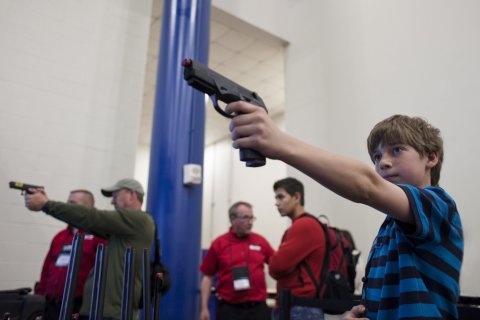
That is why the laws on private sales are absurd. While the NRA "demands" that guns be kept out of the hands of criminals, it has always blocked the only means of doing so: universal background checks on private-party sales. Polls show overwhelming support for checks—as much as 92 percent in a Quinnipiac University poll from last year, including 86 percent of Republicans.
But first the background check process has to be tightened up across the board, as was made obvious in the case of Dylann Roof, the man arrested for the recent shooting spree in an African Methodist Episcopal church in Charleston, South Carolina. Roof obtained a .45-caliber pistol in April from a federally licensed gun dealer but never should have been able to. He was charged in February with possession of a prescription narcotic, which would have prohibited a dealer from selling him a firearm. Under the rules, the government had three days to check out Roof. Because of a mix-up, the Federal Bureau of Investigation was still trying to obtain his arrest record after the three days passed. While national gun dealers won't sell weapons without FBI clearance, smaller stores are less careful. So Roof returned after the three days and, with no completed background check, bought his gun. The lesson? All gun transactions have to use the national chain standards and wait for the FBI's OK.
The last compromise gun advocates should make is based on the words of that conservative hero, Ronald Reagan: "There is no reason why on the street today a citizen should be carrying a loaded weapon." In his statement, issued as governor in May 1967, Reagan was referring to members of the Black Panther Party—Second Amendment absolutists—who walked into the California State House openly carrying rifles to protest a gun control bill.

Reagan's statement—directed at those Black Panthers publicly brandishing their weapons—should be no different when applied to gun zealots walking through a Chili's restaurant in San Antonio carrying long guns. Or the buffoon with an AR-15 loaded with a 100-round drum who last month walked around an Atlanta airport. Or the nitwit in Gulfport, Mississippi, who menaced shoppers at a Wal-Mart by loading and racking shells into a shotgun a few weeks ago, forcing an evacuation of the store. In all of these states, that near-sociopathic behavior was legal. But how can anyone tell whether these nincompoops parading around with their guns on display are merely acting like a 4-year-old proudly showing everyone his penis or constitute a deadly menace? Ask someone at the posh Omni Austin Hotel in Texas; earlier this month, a man walked around the lobby with a rifle, legally scaring people. Then he shot and killed someone.
In this great compromise, that is all the gun controllers get: a ban on high-capacity magazines and other slaughter accessories, universal background checks and a ban on the public display of weapons. That brings us to what gun enthusiasts should receive in the bargain.
First, anyone who wants to obtain a license to carry a concealed weapon should be given one. All states allow for concealed carry, but many states—like California, New Jersey and Maryland—have what are called "may issue" statutes, meaning people who qualify for a license might not be allowed to receive one. In some states, it's up to county officials to decide who gets to carry a gun inside his or her coat. Here's reality: A criminal or disturbed person will carry a concealed weapon, licensed or not. Under the universal background check system, anyone walking into a state office seeking a concealed carry permit has already been screened; there's no reason to deny that person a license if he or she meets the additional requirements.
Then there are the gun accessories that have spooky names, but are mostly designed to protect the shooter. For example, flash suppressors have been outlawed on the belief they will be used to minimize the chance of spotting a shooter. That is a consequence of the device, not its purpose. In truth, the main reason flash suppressors exist is to disburse burning gases that exit the muzzle of a long-arm gun; this minimizes the chance that the shooter will be blinded in low-light environments. Danger to the public from this accessory: none.
Other accessories also pose minimal danger, and they protect or help gun owners. For example, the barrel shroud and the folding stock were banned in 1994, then legalized in 2003. Gun control advocates have been pushing for them to be declared illegal once again. The reasons are silly. The shroud cools the barrel of the gun, making sure it does not overheat during rapid firing. It is scary looking but doesn't pose any realistic threat. A folding or collapsing stock is used on a long gun and makes it easier to store or transport the weapon. These were outlawed out of a fear that killers would be able to hide their rifles; again, not a reasonable consideration in a world filled with semi-automatic pistols.

It's also time to end this nonsense about "cop killer bullets." Although this topic has been debated since the late 1980s, there is still no accepted definition for this ammo. Earlier this year, though, the Bureau of Alcohol, Tobacco, Firearms and Explosives proposed banning armor-piercing 5.56-millimeter M855 "green tip" rifle rounds as cop killers. Some gun owners use this bullet in big, heavy AR-15 pistols, so ATF decided that the M855 green tip posed a threat to police officers who wear body armor. Problem is, not only is this exceptionally popular rifle ammunition, but ATF can point to no instance in which an officer was shot through body armor by an M855. Faced with outrage by gun owners, ATF dropped the proposal. It should stay dropped.
And so should efforts to ban assault weapons. One fact few gun opponents seem to know: Assault weapons don't exist. There are assault rifles, but the broader category of weapons that were banned in 1994 and legalized in 2003 are a political construct. Again, many of them look scary because of the cosmetic features added by gun manufacturers. But the only thing that makes them more dangerous than any other weapon is the number of bullets they can shoot—an issue dealt with by a ban on high-capacity magazines. A 2004 report for the Justice Department showed that, prior to the ban, the firearms defined as "assault weapons" were used in as few as 2 percent and no more than 8 percent of all gun crimes; almost none of those cases involved assault rifles. However, high-capacity magazines accounted for between 14 percent and 26 percent of all gun crimes. In other words, when it comes to assault weapons, Americans should stop worrying about the guns and pay attention to the bullets.
There it is: a series of reasonable proposals with something to hate for everyone. But extremists on both sides will never get what they want—all guns everywhere or no guns anywhere. It is up to the rational middle—the vast majority of Americans—to tell the fanatics that the grown-ups are taking over.
The reporter created a YouTube video that answers your questions about this article. Below is a trailer of excerpts. To see the full video, click here.
Correction: This article originally incorrectly stated that statistics compiled by the Violence Policy Center show that in the years Barack Obama has been president, there have been 14 mass shootings involving high capacity magazines, killing 125 people and wounding 153 more. In fact, there have been 18 mass shootings involving high capacity magazines, killing 153 people and wounding 137 more.


